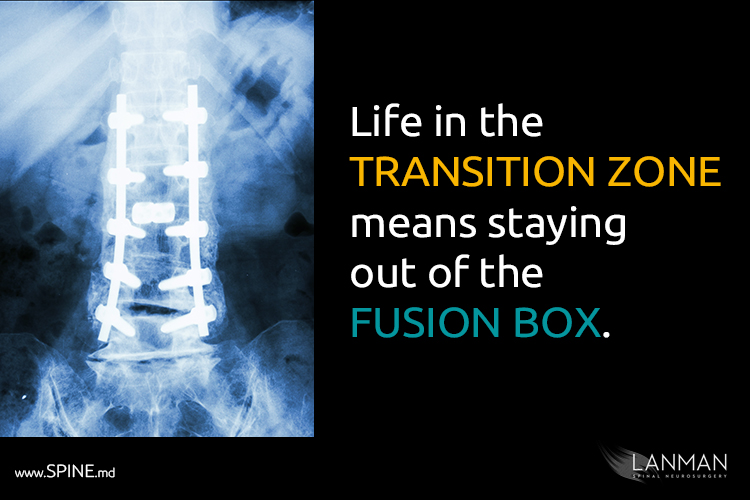All around the web, you’ll find information about how surgeons can fix your neck or back pain with minimally invasive techniques. Some procedures are performed on an outpatient basis. You can literally be cured of a chronic spine disorder and be out of the office in a matter of hours and ready to go back to a painless life. But it’s not always that simple, and surgery is not always the best answer.
Minimally invasive surgery is an excellent option, but it’s only one aspect of treatment. Another aspect of treatment is invasive surgeries like spinal fusion and artificial disc replacement. There is also the non-surgical aspect where you’ll find options like physical therapy, fitness, nutrition, supplements, and disease screening.
Between these three aspects is what I call the transitional zone that can take one patient 10 to 20 years to cross. That’s one the reasons I get frustrated with surgeons who instantly fixate on spinal fusion as some kind of “ultimate cure.”
A patient of mine is an “A” level tennis player, an actor, singer, young and very fit. But he had chronic radiating pain in his back and leg. What I found was that he had degeneration in the joints of the spine although his disc appeared relatively healthy. There were some areas of nerve pinching which could be relieved with minimally invasive surgery. However, there was also arthritis in the joints of the spine which was contributing to his pain in his back.
I’ve been in practice as a neurosurgeon specializing in treating disorders of the spine for more than 25 years. I’m also a professor at the University of California Los Angeles, and a member of the Cedars-Sinai Institute of Spinal Disorders. I do not react emotionally to patient situations. But when I met this patient and heard that he had received a recommendation for spinal fusion, that got me.
It’s true that patients with arthritis in the spine are more challenging to treat. When you get to this level of pain, the minimally invasive procedures are often not the best options. But why – of all things – perform fusion on a young man in the middle of his career, mid-stride in the prime of his life?
Fusion is what I call the “brute force” surgical procedure. To stop the pain, it immobilizes the bones in the spine. That was a great option 100 years ago when that’s all that medical science had. The cost is the permanent loss of free and natural movement of the spine. For this man, it just was not an answer. And that’s what led him to me.
He had read about my clinical research on artificial disc replacement; studies that I worked on that showed superior results that disc replacement patients experienced over those who had fusion. He was encouraged and anticipated that this was something he might do.
However, I recommended a combination of actions. First, there was micro-decompressive surgery, which is relatively minimally invasive, to relieve pressure and pinching of the nerves. Then, to help stabilize the joints and relieve the stress on the arthritic joints to reduce pain, I suggested a relatively new device called Coflex. It is a U-shaped titanium device that is implanted between the spinous processes (between vertebrae), to relieve joint pressure on the arthritic joints. I placed two of these devices in this patient, and within three months he was back to his usual life. It’s been three years since his surgeries, and he has experienced excellent results with no complaints.
Back to the transition zones, inevitably, he may need fusion. It’s hard to predict, but in cases like arthritis, joints may continue to fail in spite of the device. I will predict that fusion is a long way off for him, despite arthritis. He retains his full natural movement. He has his life to live.
It is my primary treatment philosophy to preserve motion. I can give a patient significant reduction in pain, but I will always opt for a way to protect an active lifestyle and delay that “brute force” for 10, 20, or more years.
I’m an advocate for artificial disc replacement, but that doesn’t mean ADR is always the answer. When a patient comes to me with degenerative disc and relatively healthy facet joints, then indeed disc replacement is on my mind. But there are always situations where the patient needs more than just one answer.
Once you have been diagnosed with a spinal disorder, you are living in the transition zone. Whether you need spine surgery to alleviate your neck and back pain is something that you should discuss with your spine surgeon. It is not unreasonable that you may need surgery. But, I urge that you advocate for preserving mobility for as long as possible.







